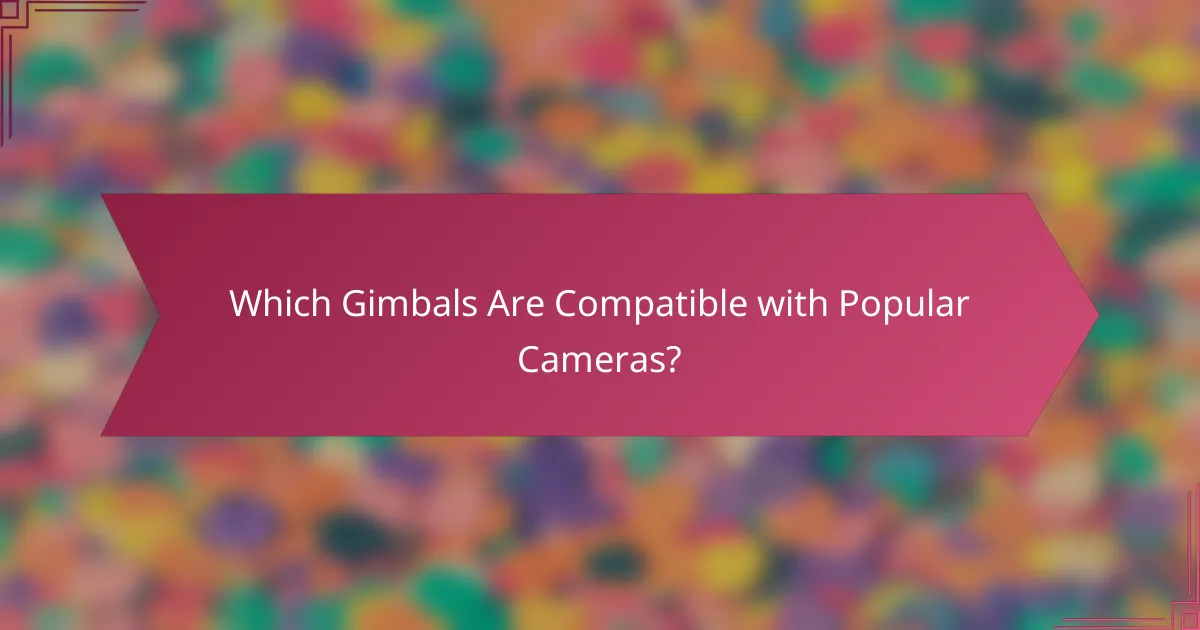Selecting the right gimbal involves balancing stability, weight, and compatibility with your camera equipment. A gimbal that minimizes shake while being lightweight can enhance your shooting experience, but it’s crucial to consider its weight capacity and motor strength. Additionally, ensuring compatibility with your camera model will help you achieve optimal performance and ease of use.

What Are the Best Gimbals for Stability?
The best gimbals for stability are those that effectively minimize camera shake while providing ease of use and compatibility with various devices. Key factors to consider include the gimbal’s weight capacity, motor strength, and design features that enhance balance and control.
DJI Ronin-S
The DJI Ronin-S is renowned for its robust stabilization capabilities, making it a top choice for both amateur and professional filmmakers. It supports a wide range of camera weights, typically up to 3.6 kg, which allows for versatility in equipment selection.
Its ergonomic design and intuitive controls facilitate smooth operation, even during dynamic shooting scenarios. The Ronin-S also features advanced modes like ActiveTrack, which automatically follows subjects, enhancing creative possibilities.
Zhiyun Crane 3
The Zhiyun Crane 3 offers exceptional stability with a maximum payload of around 4.5 kg, accommodating heavier camera setups. Its innovative design includes a detachable handle, allowing for various shooting angles and improved maneuverability.
This gimbal is equipped with a touchscreen interface for easy adjustments and settings management. Additionally, the Crane 3 supports multiple shooting modes, such as Vortex and Go mode, catering to different filming styles.
FeiyuTech AK2000
The FeiyuTech AK2000 is a lightweight yet powerful gimbal, supporting cameras up to 2.2 kg. Its compact design makes it ideal for travel, while still providing excellent stabilization for smooth footage.
With features like a quick-release plate and multiple follow modes, the AK2000 is user-friendly and adaptable for various shooting conditions. It also includes a battery life of approximately 12 hours, ensuring extended use without frequent recharging.

How Does Weight Affect Gimbal Performance?
The weight of a gimbal significantly influences its performance, affecting stability, battery life, and ease of use. A heavier gimbal may provide better stabilization but can be cumbersome during extended use, while a lighter model may sacrifice some stability for portability.
Impact on battery life
Heavier gimbals often require more powerful motors to maintain stability, which can lead to increased battery consumption. This means that while a robust gimbal might perform better in terms of stabilization, it may also have a shorter operational time, potentially lasting only a few hours on a single charge. In contrast, lighter gimbals typically consume less power, extending battery life but possibly compromising on stabilization.
Ease of use for handheld shooting
A lighter gimbal is generally easier to handle during handheld shooting, allowing for longer periods of use without fatigue. This is particularly important for videographers who need to capture footage over extended sessions. However, a lightweight gimbal may struggle with heavier camera setups, leading to less effective stabilization and shaky footage.
When selecting a gimbal, consider the weight of your camera and accessories. Aim for a gimbal that balances well with your setup, ensuring that it remains manageable while providing the necessary stability for your shooting style.

Which Gimbals Are Compatible with Popular Cameras?
Many gimbals are designed to work seamlessly with popular camera models, ensuring stability and ease of use. Compatibility varies by brand and model, so it’s essential to check specifications before purchasing.
Canon EOS R compatibility
The Canon EOS R is compatible with a variety of gimbals, including the DJI Ronin-S and Zhiyun Crane 2. These gimbals provide excellent stabilization and support the camera’s weight effectively.
When selecting a gimbal for the EOS R, consider the payload capacity and the gimbal’s features, such as follow focus and remote control options. Ensure the gimbal can handle the lens you plan to use, as heavier lenses may require a more robust model.
Nikon Z6 compatibility
The Nikon Z6 pairs well with gimbals like the Moza Air 2 and the FeiyuTech AK2000. These options offer solid stabilization and are user-friendly for both beginners and experienced videographers.
Check the gimbal’s weight limit to ensure it can support the Z6 along with any additional accessories, such as microphones or external monitors. Look for gimbals that allow for easy balancing adjustments to accommodate different setups.
Sony A7 III compatibility
The Sony A7 III is widely compatible with gimbals such as the Zhiyun Weebill S and the Ronin-SC. These gimbals are known for their lightweight design and advanced stabilization features, making them ideal for handheld shooting.
When choosing a gimbal for the A7 III, consider factors like battery life and ease of setup. Many gimbals offer quick-release plates, which can save time during shoots. Ensure that the gimbal supports the A7 III’s weight, especially when using larger lenses.

What Factors to Consider When Choosing a Gimbal?
When selecting a gimbal, focus on its payload capacity, battery life, and control features. These factors directly influence the stability, usability, and overall performance of the gimbal with your camera setup.
Payload capacity
Payload capacity refers to the maximum weight a gimbal can support. It’s crucial to choose a gimbal that can handle your camera and any additional accessories, such as lenses or microphones, without compromising stability.
For most consumer gimbals, payload capacities typically range from 1 to 4 kg. If you’re using heavier equipment, consider professional models that can support up to 10 kg or more.
Battery life
Battery life is essential for prolonged shooting sessions. A gimbal with a longer battery life allows for extended use without frequent recharging, which is particularly important for events or outdoor shoots.
Most gimbals offer battery life between 6 to 12 hours. Look for models with removable batteries for quick swaps, especially if you plan to shoot for several hours at a time.
Control features
Control features enhance the user experience and flexibility of the gimbal. Look for options like joystick control, smartphone app integration, and customizable settings to tailor the gimbal’s performance to your shooting style.
Some advanced gimbals include features like object tracking and time-lapse modes, which can significantly improve your shooting capabilities. Ensure the controls are intuitive and easy to access while filming.

How to Test Gimbal Stability?
To test gimbal stability, focus on assessing how well the gimbal maintains a steady shot under various conditions. This involves both static and dynamic tests to evaluate performance in different scenarios.
Static tests
Static tests involve using the gimbal in a stationary position to check its balance and stability. Place the gimbal on a flat surface and observe if it remains level without drifting. A well-calibrated gimbal should hold its position without any noticeable tilt or movement.
Additionally, you can perform a simple test by attaching a camera and recording a still scene. Review the footage for any unwanted vibrations or shakes. If the image is stable, the gimbal is functioning correctly in static conditions.
Dynamic tests
Dynamic tests assess gimbal stability during movement. This includes walking, running, or panning while recording. The goal is to observe how well the gimbal compensates for motion and maintains a smooth shot. A good gimbal will minimize shakes and jolts, providing fluid video output.
To conduct a dynamic test, try different speeds and movements. For instance, walk briskly while filming, then switch to a slow pan. Evaluate the footage for stability; if the video remains smooth across various movements, the gimbal is performing well.

What Are the Best Practices for Gimbal Setup?
To achieve optimal performance from your gimbal, focus on proper balancing, calibration, and compatibility with your camera system. These practices ensure stability and enhance the quality of your footage, making your setup more efficient and effective.
Balancing techniques
Balancing your gimbal is crucial for smooth operation. Start by adjusting the tilt, roll, and pan axes to ensure that the camera remains level when the gimbal is powered off. A well-balanced gimbal reduces motor strain and extends battery life.
Use the following steps for effective balancing: first, mount your camera securely, then adjust the position of the camera on the gimbal’s plate until it remains stationary in all orientations. Check the balance by tilting the gimbal in various directions; it should hold its position without drifting.
Calibration steps
Calibration is essential for ensuring that your gimbal responds accurately to your movements. Begin by powering on the gimbal and allowing it to stabilize. Follow the manufacturer’s instructions to access the calibration settings, which typically involve setting the gimbal to a flat surface.
After calibration, perform a test run to verify that the gimbal tracks your movements smoothly. If you notice any lag or drift, recalibrate and check the balance again. Regular calibration is recommended, especially after changing camera setups or after extended use.
